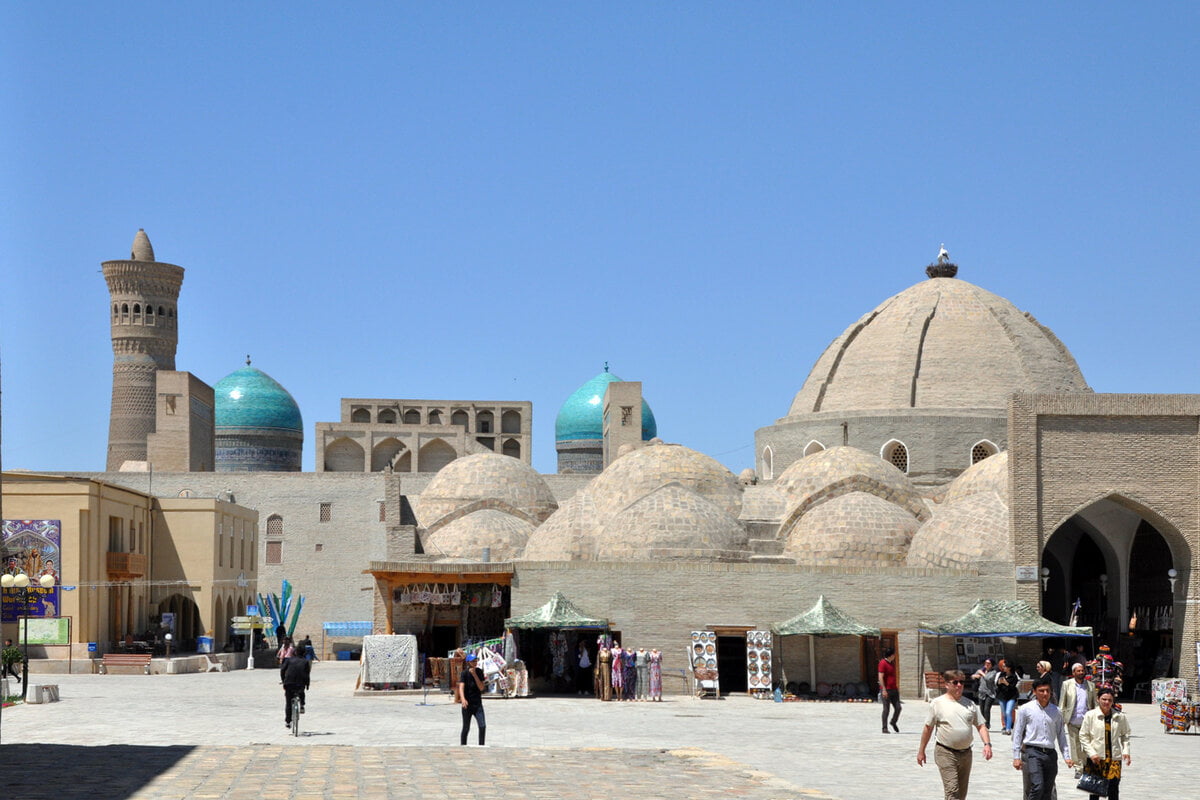Bukhara - Toqi Telpak Furushon

Toqi Telpak Furushon in Bukhara: A historical trading centre
Toqi Telpak Furushon in Bukhara (also Taqi Telpakfurushon in some sources) is one of the most remarkable preserved traditional indoor bazaars in the city. It was built in 1570-1571 during the reign of Abdullah Khan II, one of the important rulers of the Shaybanid dynasty. The Shaybanids, who played a key role in the rise of Bukhara as a major trading centre, began building such bazaars to make Bukhara a hub at the crossroads of numerous caravan routes. These trade domes symbolised the success of these endeavours and gathered merchants from different parts of the world under their roofs.
The building material for this unique structure was ceramic tile. Toqi Telpak Furuschon is characterised by its unusual architecture, with a hexagonal basic shape that offers a particularly compact and functional solution for building at the intersection where five streets converge. The central dome of the building is a strikingly beautiful spherical construction that is ventilated through small openings. This dome is supported by six mighty pylons and has 12-sided lighting, which is of particular interest to tourists as they have the opportunity to view the dome from the inside. The diameter of the main dome is an impressive 14.5 metres.
There are smaller domes with niches above the main shopping arcade of the bazaar. Around the central dome are warehouses, caravanserais and storehouses, which were used by visitors for trading goods. The western exit leads to Mekhtar Ambar Street, where the ancient caravanserai of Kuleta can be visited, a resting place for travellers from the past. Today, the trading dome is an important part of the historical centre of Bukhara and has been inscribed on the UNESCO World Heritage List due to its cultural and historical significance.
In the 16th century, Bukhara experienced an economic boom and became an important shopping centre. The bazaars along the streets were transformed into large markets, and a special feature of this period was the specialisation of shops according to the type of products on offer. Trading domes were built to provide the most favourable trading conditions for merchants on the Great Silk Road. These multi-ventilated domes, also known as ‘currents’, were built at crossroads and marketplaces to promote the exchange of goods. Traders from India, the Russian Empire, Iran, China and many other countries came together here.
Initially, Toqi Telpak Furushon was a centre for the book trade, which is why it was originally called Kitab-Furushon, which literally means ‘the dome of booksellers’. Over time, however, other merchandise, especially headgear, began to be sold under the dome. The products on offer included embroidered beads, headdresses made of gold and precious stones, massive telpaks (fur hats), fur hats, turbans and chugurmas (hats made of fur and sheep’s wool). These products were bought by both locals and foreign visitors, and the tradition of headgear has survived to this day. Due to changes in the direction of trade within the dome, the name was eventually changed to ‘Toqi Telpak Furuschon’, which literally means ‘the dome of headwear merchants’.
The name ‘Telpak’ refers to the traditional headdress made of sheep’s wool, which still plays a role in this historic trading centre today. Today, tourists can visit the Toqi Telpak Furuschon to stroll around a building rich in history and purchase handmade souvenirs, antiques, clothing, scarves and other handicraft products. The numerous scarves and beautiful hats on sale are particularly popular. Tourists can bargain with the sellers to lower the price, but the prices are usually not as high as often described in tourist reports.
A visit to Toqi Telpak Furushon is particularly pleasant after a visit to the madrassas and mosques of the old town, as you can walk along the colourful eastern rows of shops. The covered shopping arcades not only offer protection from the sun, but also a refreshing breeze that makes the visit even more pleasant. Near the bazaar is a smithy where traditional knives and other tools are made using ancient techniques – another fascinating testimony to the craftsmanship of Bukhara.
Toqi Telpak Furushon remains a fascinating example of the architecture and trade of medieval Bukhara and one of the most famous sights of this historic city.
